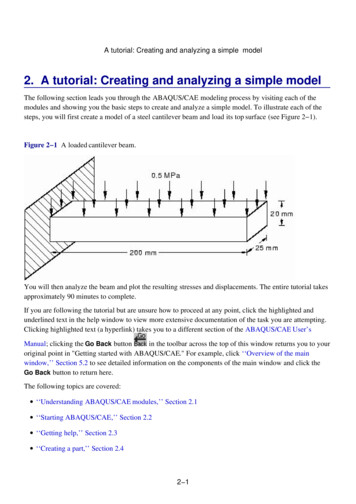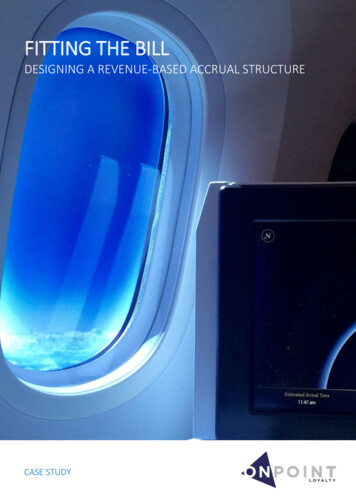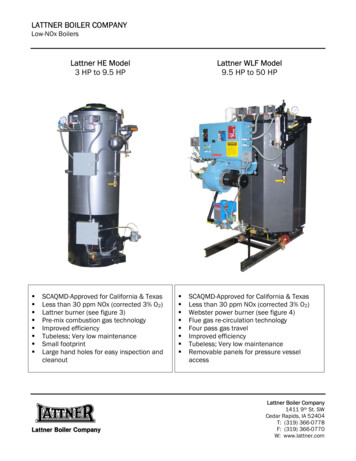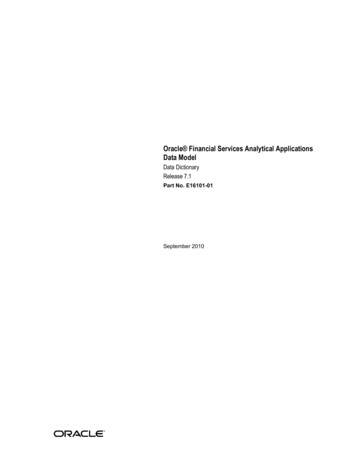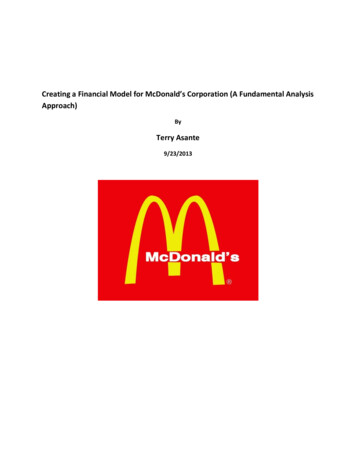
Transcription
Creating a Financial Model for McDonald’s Corporation (A Fundamental AnalysisApproach)ByTerry Asante9/23/2013
Dedicated to Ms. Lori (Loretta) Anderson for believing in me, to Professor Simon Benninga for creating aframework to model a company, to my parents, to my brother Tony Asante, and to the creator.
Creating a Corporate Financial Model for McDonaldsIf you have ever turned on the television to watch Bloomberg News or MSNBC, it would not besurprising to see stock quotes at the bottom of the screen or financialcommentatorsand Wall Streetanalyst discussing valuations of the S&P 500 companies. How do financial commentators and Wall Streetanalyst derive at the valuations of a company? What methods and procedures are they using toestimate the intrinsic value? To calculate a value of stock, investment bankers, equity research analystand portfolio managers use corporate financial models to project the financial statements (pro-forma)of a company. The outputs of the models allow them to use a method such as the discounted cash flowto derive at the price of the business (thorough explanation on DCF will be provided later in the guide)The pro-forma financial model allows the analyst to assess the following: How much free cash flow will the company generate in the future under different economicscenarios (financial parameters)How will margins due to increased competition affect operating income (Earnings beforeinterest & taxes)The earnings drivers of a companyThe level of working capital and fixed assets at a particular sales growthThe level of equity and debt financing to achieve a certain sales growth and its effects on thecompany’s capital structureCreating a corporate financial model requires the analysis of the economy, industry, business, andhistorical corporate financial statements. Only after analyzing these elements can we build a pro-formamodel that translates the operating and financing activities of a firm into a simple spreadsheet, whichwill allow us to estimate the value of a company. To carry out this process, we will use a real worldcompany such as McDonalds Corporation.This systematic guide will give you the tools and ability to understanding how to predict the economicand financial performance of McDonalds. We will use the historical financial statements to calculatefinancials ratios from the balance sheet and income statements to obtain parameters to forecast howthe future financial performance of the firm.To increase your learning aid, I have created an excel spreadsheet for McDonalds using historicalfinancial statements from 2004-2013. In addition, there is a PowerPoint explaining all of the parameters,procedures, and calculations to speed your learning effectiveness. It will also prove useful to downloadMcDonald’s 2012 annual report to understand the intuition behind the accounting numbers as we gothrough the analysis from economic, industry, business, historical, & projected financial statements andvaluation analysis.
Economic & Industry AnalysisBefore we can understand the drivers of McDonald’s operations, we have to analyze the economy andindustry, to assess whether or not McDonalds’s strategy, product, & market focus is aligned with thecurrent environment. According to Standard & Poor’s Restaurant Industry Survey as of December 2012,“restaurant sales are driven by consumer spending.” The main factor driving how much a consumerspends is based on their employment prospects. Thisis quantitatively captured through theunemployment rate and personal disposable income, which is the amount of income a consumer hasavailable to spend after netting, taxes.Unemployment RateThe U.S unemployment rate as of May 2013 is 7.6%, far below the level at 10.2% in 2009.Unemployment rate is important to consider in our analysis because it can determine a restaurantstrategy in terms of product mix and what targets market it chooses to focus. At high unemploymentrates, restaurant operators will focus their product mix on value offerings. For instance, in the secondhalf of 2012, McDonald has experienced softer performance in the U.S and adjusted its product mix oneveryday value offerings while providing menu variety. Restaurant operators in the fast casual industrysuch as Panera Bread and Chipotle will not try to compete on price with McDonalds (Limited-RestaurantIndustry) even if unemployment rates are excessively high. The customers at Panera Bread and Chipotleare willing to a price premium (pricing power) for higher quality food items. There are willing to allocatemore of their disposable income to obtain these items.Real disposable Income (Personal Income – Personal Income Tax Payments)As stated in the S&P 500 RestaurantIndustrySurvey, U.S consumers’ real disposable income rose 3.7% inthe 1st quarter of 2012 and 3% in the second quarter of 2012 and grew only 0.8% in the third quarter. S&P Capital IQ is expecting 2013 real disposable personal income to grow by 3.4% in 2013. With such lowgrowth in real disposable income, some restaurant companies are expanding to the emerging marketssuch as China and Indiato generate more earnings and cash flows due to their rising middle class andincreased purchasing power. According to theindustry, survey “the annual per capita disposableincome of the urban population increased with acompound annual growth rate (CAGR) of 11.8%between 2000 and 2010, according to the NationalBureau of Statistics of China.” In 2011, the percapita disposable income of urban residents grewby 8.4%Analyzing the industry-Competitive Rivalry
Operating in a highly fragmented industry, McDonalds faces competition at every corner. According tothe National Restaurant News, the restaurant market consist of eight segments with their respectivemarket segments: Buffet -0.8% convenience store -1.9%, Bakery Café- 2.0%, Hotel- 2.6% , Snack-7.7%,family – 5.5%, chicken-6.7%, pizza-6.9%, casual dining-17.0%, sandwich- 46.3% and other-2.6%. With amarket share of 46.3%, the sandwich segment consist of hamburgers, chicken, fish sandwiches, tacosand burritos. As indicated in the figure to left, the total combined domestic sales of the top 100 chainsas of 2011 are 205.7 billion dollars. Companies operating in the restaurant industry compete based onprice, convenience, service, menu variety, and product quality.PriceThe price a restaurant operator charges depends on its market segment. According to EuroMonitorInternational, a leading source of market data with respect to the global restaurant industry, therestaurant categories consist of quick-service eating establishments, casual dining full-servicerestaurants, 100% home delivery/takeaway providers, street stalls or kiosks, specialist coffee shops,juice/smoothie bars and self-service cafeterias. Pricing within the quick-service industry is highlycompetitive due to the minimal start-up cost. To increase traffic and guest counts, Companies such asMcDonalds’s, Jack-In-Box and Wendy’s offer value menus to appeal to the value conscious consumer. Aneconomy of scale in purchasing supplies and being located high traffic areas allows these threerestaurant chains to remain price competitive.ConvenienceA restaurant company can make itself more convenient by being in the right location, expanding to overgeographical markets, and extending its operating hours. For instance, most restaurants seek to situatenear office complexes, hotel & entertainment centers, and retail centers. Comparable sales, which are akey industry metric, are driven by changes in guest counts and average check. Highly populated areasincrease the chance that guest counts and sales will rise .Furthermore, a restaurant operator can makeits self-more convenient by expanding into various geographical segments. For instance, in 2013McDonald’s is planning to expand its market presence in Europe and APEMA (Asia/Pacific, Middle East,and Africa).ServiceService in financial terms with respect to the quick-service restaurant industry is how fast they can turntheir inventory into cash. Because the quick-service restaurant industry is highly volume driven,transaction speed is very important. Higher transaction speed means lower wait times, which helpsdrive volume and sales. We can measure the efficiency of a restaurant by using the inventory turnoverratio and days in inventory ratio.Menu varietyMenu variety can be a source of innovation that allows a restaurant company to generate sales throughmore menu items. In addition, new menu items can raise traffic without margin pressure or price
discounting. Average check size for quick or limited service restaurants are always less than 7. To avoidmargin pressure and the increase in commodity & labor cost occurring in quick-service industry,restaurant companies seek to differentiate themselves by offering premium products that generatemore margins. We can observe the success of a McDonald’s menu variety by assessing its gross andoperating margins.Product Quality –Higher quality meals and food items can increase the average check size for a restaurant operator andcontribute to margin expansion if a restaurant is able to control operating expenses. Higher productquality can also be analyzed through observing a company’s gross and operating margins.Labor and Commodity costLabor and commodity cost remains one of the largest expenses for a restaurant operators and can havea significant effect on the restaurant margins if the firms operating in the industry are not positionedwhether through pricing, product mix or location. According to the Standard & Poor’s RestaurantIndustry Survey as of December 2012, “higher labor cost continued to impact the retail industry in 2011,due to an increase in hourly compensation payments caused by increase in the federal wage. As a result,many restaurant operators are resulting to price increases to compensate.” As reported by NationalRestaurant Association 2010 Restaurant Industry Operations Report, 29.4% of the Limited ServiceRestaurant industry dollar was allocated towards wages and benefits and 31.9% was allocated towardsthe cost of food and beverages. Restaurant operators seek to mitigate the vicissitudes of raw materialprices by negotiating with suppliers to lock in at a certain price in the future, also known as hedging.Firms like McDonald’s use their there market size and financial capital to obtain raw materials atcompetitive prices further increasing their gross, operating, and net margin. Below are the allocation ofthe industry dollar for restaurant industry provided by the National Restaurant Association’s for 2010Industry Operations Report.61.3% of the industry dollar for limited service restaurants was allocatedtowards cost of food & beverages and wages & Benefits. Labor and commodity cost alongside a firmproduct mix and sales volume are key components affecting a restaurant operator sales.Industry GrowthThe industry growth of a firm’s industry can be a key driver for its financial performance and its intrinsicvalue (the actual value of company determined by estimating the future cash flows and discounting it atthe appropriate rate of return). It is stated by Hoover’s/ D& B subsidiary First Research, the output of USFood Services and drinking places, an indicator for fast food and quick service restaurants, is forecasted
to grow at annual rate of 4 percent between 2013 and 2017. On the other hand, under the industryprofile section of the S&P 500 Industry Survey, S&P Capital IQ (S&P) expects revenues to rise about 2%-3in 2013. In our valuation model, we will adhere to a long-term free cash flow growth rate i/a/o 3.0%Analyzing the BusinessCompany OverviewMcDonald’s corporation operates and franchises restaurants globally. At the end of 2012, 27,882restaurants were franchised or licensed and the company operated 6,598 restaurants. McDonald’s hasgeographical presence in markets such as Europe, Asia/Pacific, Middle East and Africa (“APMEA”). TheU.S., Europe and APMEA account for 32%, 39% and 23% of total revenues, respectively. Sales generatedby McDonald’s corporation consist of company-operated restaurants and fees from restaurantsoperated by franchisees, rent and royalties from conventional franchised restaurants based on a percentof sales along with minimum rent payments and initial fees. Furthermore, McDonald’s receives a royaltybased on a percent of sales, which include initial fees from affiliates and developmental licensees.McDonald’s core strategy as of 2012 is optimizing their menu, modernizing the customer experience andthe accessibility of its brand all over the world. Some of McDonald’s main products and services are BigMac, Quarter Pounder with Cheese, Filet-O-Fish, Snack Wraps, Egg Mcmuffin with egg and Mccafebeverages. McDonald’s customer profile reaches all groups ranging from the budget conscious andpremium customers. To ensure reliable and consistent supplies to meet inventory demand, McDonaldsrelies upon numerous independent suppliers.Operations OverviewThe success of McDonald’s operation its efficient supply chain management system that allow them toleverage scale to obtain competitive prices which benefits their margins all while staying pricecompetitive in market. To mitigate the risk high commodity cost, McDonald’s enter into forwardcontract to stabilize food cost. McDonald’s innovative distribution capability enables them to achievesuperior inventory turnover alongside with robust profit margins. By having extended hours, an efficientdrive-thru service, multiple order points to maximize drive thru capacity alongside the implantation of1,500 hand-held order takers to improve customer service, McDonald’s wide economic moat remainsuntouched. Below are McDonald’s business tactics and future plans.
U.S 900 existing restaurants were remodeled with the majority adding drive thru capacity toimprove the customer experience and to grow customer traffic.1,500 hand held orders takers have been implemented to improve t
23.09.2013 · industry, to assess whether or not McDonalds’s strategy, product, & market focus is aligned with the current environment. According to Standard & Poor’s Restaurant Industry Survey as of December 2012, “restaurant sales are driven by consumer spending.” The main factor driving how much a consumer spends is based on their employment prospects. Thisis quantitatively captured through
